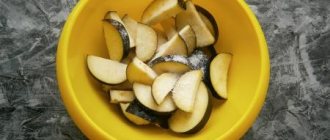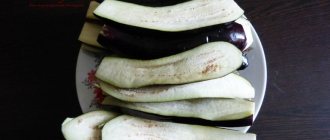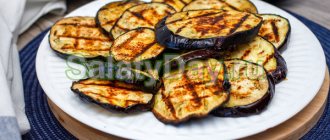Vegetable growing » Eggplant
0
2027
Article rating
Kira Stoletova
Eggplant is a tasty but specific vegetable. It makes unusual and flavorful dishes if it is prepared correctly. Thus, most housewives recommend peeling eggplants before cooking to add piquancy to the dish and remove bitterness.
Cleaning eggplants before cooking
How to choose the right eggplants
A delicious vegetable dish will only turn out if you use high-quality and fresh ingredients for its preparation. When choosing eggplants, you need to follow the advice of gardeners, which will help you avoid buying spoiled or unripe vegetables.
Rules for choosing blue ones:
- You should avoid purchasing vegetables that have brown spots on the skin. They indicate that the fruit is not fresh.
- On average, 1 large eggplant should weigh from 350 to 500 g. If the vegetable you are looking at has less weight, then it was picked early or has already begun to deteriorate.
- There should be no defects on the skin of the blue ones (dents, scratches, etc.). The presence of any flaws indicates the beginning of the rotting process.
- A low-quality eggplant will have a dry, brown stem.
- The shine and smoothness of the surface layer of a vegetable is the main sign of quality.
- If you press your finger on an overripe or early-picked fruit, a dent will remain on it. The pressure mark on a timely harvested vegetable will disappear in a few seconds.
- You should choose medium-sized fruits. Large eggplants have a high concentration of solanine (a toxic substance), so you should avoid buying them. Small vegetables indicate insufficient maturity or improper cultivation of the garden crop.
- The seeds inside the blue ones should be small and light. At the same time, they will not emit an unpleasant odor. Vegetables grown with chemicals will have large seeds and a light brown color.
- The presence of green areas on the fruit pulp indicates a high concentration of solanine.
- After cutting the vegetable, the flesh should not change color. Otherwise, it contains many chemicals that are harmful to health.
Do I need to peel eggplants before cooking?
There are many questions regarding the use of eggplants for food. Some people consider this product unhealthy, others do not know how to prepare it correctly. In addition, housewives are often interested in whether they need to be cleaned before cooking.
This question arises because the peel of the product contains solanine, which is a toxic substance. If there is an excess of it in the body, poisoning can occur, so some people believe that eggplants must be peeled before eating. But it is not so.
Whether to peel a vegetable or not is up to each person to decide individually. It does contain solanine, but at the same time there are many elements useful for the body. Solanine can make eggplant taste bitter, which is why you have to remove the peel.
But you can also eliminate bitterness by soaking the product in a saline solution, which will eliminate the need for cleansing. Therefore, this issue is worth understanding in more detail.
Beneficial properties of the skin
The peel contains almost all the microelements that the vegetable itself contains. It contains:
- vitamins C, B, P, D;
- phosphorus;
- sulfur;
- potassium;
- magnesium;
- calcium;
- zinc;
- fluorine;
- cellulose;
- pectin, etc.
Thanks to these substances and elements, the product brings significant benefits to the body:
- helps eliminate excess cholesterol;
- preventing the occurrence of atherosclerosis and heart disease; accelerates the process of hematopoiesis;
- strengthens bones;
- increases the elasticity of blood vessels;
- normalizes intestinal activity;
- reduces weight.
The harm of the vegetable, as already mentioned, lies in the solanine it contains. Its excess leads to poisoning, so those who have gastrointestinal diseases should handle this product very carefully. A significant part of this substance is contained in the peel, which somewhat reduces its nutritional value.
But in the absence of significant health problems, eggplant can be eaten with the skin - there will be no harm. In addition, the effects of solanine can be neutralized by soaking it in a saline solution or stewing it. This means that peeling is not necessary.
Signs of solanine
In addition, peeled eggplant does not retain its beneficial properties for long. The peel protects the vegetable from drying out, and it also withers and rots less. Therefore, if you decide to remove the skin, you should do this immediately before preparing the product.
However, there are cases in which it is necessary to peel the product. This is influenced by the plant variety, its degree of maturity and the characteristics of the planned preparation. You need to peel this vegetable in the following situations:
- The plant variety is characterized by a pronounced bitter taste. Removing the peel in this case will reduce the bitterness.
- The plant is overripe. Young vegetables contain very little solanine, but if the eggplant is old, the skin should be removed.
- The product is not fresh. It is generally risky to eat such vegetables, but if you decide to do so, you need to take all precautions.
- The vegetable skin is too thick. It contains more solanine, and is also more difficult to chew. Although if heat treatment and pre-soaking are planned, the skin can be left.
- The eggplants are going to be fried. When frying, the product becomes filled with cholesterol and loses many of its beneficial properties. So it's worth trying to reduce the risk by removing the skin before frying.
However, in general, the question of peeling this fruit must be decided by everyone independently. Everyone's taste preferences are different and some people like the bitter taste that the vegetable develops when the peel is preserved.
Another important aspect is whether the product needs to be cleaned of seeds. This is also decided individually. The most important thing to consider is the size of the vegetable. The large “blue” ones have large enough seeds that they can be cut out. If the size of the vegetable is small, such manipulations are meaningless. There is almost no solanine in small seeds, but there are a lot of useful substances, so it is better to leave them.
To peel eggplants or not?
Whether to peel these vegetables or not, everyone decides for themselves. There is no urgent need to peel eggplants, but they do this mainly to reduce bitterness. The skin contains bitter and spicy substances, but they can be neutralized not only by peeling, but also by soaking the sliced eggplants in salt water.
Many people peel eggplants because it is easier to do than cutting and soaking the pulp. Some people also remove the seeds along with the peel, which are also slightly bitter in overripe vegetables.
If you don't like spicy foods with bitterness, you can peel the eggplants before or after cooking. It is also recommended to do this for caviar or stew.
Is it necessary to peel eggplants before cooking?
The culinary delights of every modern housewife are unique. Healthy food recipes deserve the most attention. And vegetables most often become their main ingredients. Along with the usual fruits of zucchini, cabbage, and carrots from the garden, eggplant has taken its rightful place on our table. After all, you can invent many unusual, tasty, nutritious, healthy dishes from it. Do I need to peel eggplants? This question interests many cooks, especially beginners.
The process of pre-processing the vegetable is also of no small importance. To this day, cooks, especially beginners, are faced with the question: is it necessary to peel eggplants?
There is an opinion that in many vegetables all the benefits lie in the peel. From a dietary point of view, the dietary fiber contained in eggplant normalizes the functions of the gastrointestinal tract. And the bitterness present in the vegetable is not in the peel, but in the pulp. Therefore, before cooking, it is recommended to soak it in water with a little salt.
If the fruit is overripe, it is better to remove the peel, but representatives of the young harvest do not need to be peeled. Therefore, there is no set rule whether you need to peel the eggplant or not. Usually this point is taken into account when choosing a dish that you want to cook.
For example, without the peel, eggplant may lose its shape when it gets into the pan, so it is important to decide for yourself whether you need to peel the eggplant before frying. Still, in order to get whole pieces when frying, you should not remove the shell from the eggplant. If the fruit is young, then it is enough to cut it into slices and, after breading, place it in hot oil in a frying pan. It is better to soak overripe chopped slices for half an hour in salt water.
If you plan to stew the blue ones, it is better to clean them before cooking. In the case of preparing caviar, puree, ajapsandal, cleaning is mandatory.
When not to peel vegetables
Old and overripe eggplants need to be peeled for any dish. However, many snacks require the skin to be on the slices. In this case, the algorithm of actions is as follows:
- Choose the youngest vegetables.
- Wash them and dry with a towel.
- Cut into circles or cubes.
- Soak in salt water for 30 minutes.
- Rinse with clean water.
- The cutting is ready for further culinary manipulations.
Advice!
Before baking or grilling, the vegetable slices are not peeled so that they retain their appetizing shape.
Why peel eggplants?
As far as we know, this vegetable is not only tasty, but also extremely beneficial for health, due to the content of substances that improve the functioning of the cardiovascular system: zinc, manganese and iron.
Scientists say that in many fruits, most of the beneficial substances are collected in the skin itself and a thin layer of pulp under it. Does this mean that eggplant should be eaten unpeeled? The worrying thing is that the skin may turn out to be hard and bitter, which will negatively affect the taste. We recommend that you resolve this issue on your own, taking into account our advice.
Eggplant peel contains health benefits
- The skin contains dietary fiber, which is often necessary for our body for the smooth functioning of the gastrointestinal tract. From a dietary point of view, the peel is healthy and nutritious.
- Overripe, old eggplants must first be peeled. Their skin is thick and rough, it has most likely already lost its good properties, and it is difficult to prepare it to the required softness. Young eggplants do not need to be peeled.
- The overwhelming majority of bitterness is not collected in the peel, but is found in the pulp. Thanks to this, skilled housewives soak sliced eggplants in salted water, which they then drain.
- Whether it is worth peeling the eggplant or not also depends on the dish you want to prepare. For example, if you need to fry or grill slices, the peel will maintain the shape of the eggplant and prevent it from falling apart. Finely chopped cubes for stews or breaded frying will not fall apart without the skin.
And finally. If you grow eggplants in your garden and do not use pesticides, nitrates or substances that accelerate fruit growth, then cleaning is not necessary. But store-bought eggplants, or those bought at the market, are still better to peel: how do you know in what conditions they were grown?
Cleaning after cooking
- Sometimes eggplants are peeled after cooking. First of all, they are put in the oven in an unrefined form, and then cleaned.
- They can also be boiled in boiling water, after which the skin will be easier to remove.
- To remove the peel better, you need to wait for the vegetable to cool completely. Peel the eggplant using a knife. The front layer will be removed without pulp.
- After heat treatment, the vegetable can soften perfectly. Then you can peel it simply with your hands or using a fork. These eggplants can be added to stews or stuffed.
Eggplants can be a great individual dish or an element of something else. To avoid bitterness, you should learn how to select and prepare them correctly. If the fruits are young, they do not need to be peeled. For overripe ones, this procedure is mandatory.
Cleaning correctly
If you still decide to peel the eggplant, you will need:
- an ordinary kitchen knife;
- a specialized paring knife or vegetable peeler;
- paper towels for the kitchen.
- Rinse the eggplant well, removing all dirt. There are usually harmful bacteria on the surface, which will get onto the pulp during the cleaning process. After washing, dry the vegetables with a paper towel.
Wash the eggplants well
- Using a sharp kitchen knife, trim the tip of the eggplant just below the base of the stem. In most cases, this part is hard and tough; it is undesirable to use it in cooking.
- The stem of the eggplant has been removed, making it much easier to peel off the skin. You can also cut off the bottom tip by about a centimeter.
Cut off the top and bottom ends of the eggplant
- Next, remove the skin in strips; to do this, place the eggplant “on the butt,” take a vegetable peeler, press the blade to the part from above and slowly move it down along the entire length.
- During this process, do not point the peeler or tilt the vegetable towards you. Move the eggplant slightly away from you or to the side.
- If you don't have a vegetable peeler, use a small knife. Also carefully move the knife from top to bottom, trying to cut only a thin layer of skin without touching the flesh.
Carefully cut off the peel with a vegetable peeler or knife.
Similarly, peel the entire eggplant without leaving any traces of peel on it.
It is necessary to pay attention: the eggplant must be peeled only in the longitudinal direction, from top to bottom. If you cut the peel across the vegetable, you risk cutting yourself, and the process will be long and inconvenient.
This cleaning option is perfect for the subsequent use of eggplants in stews, for frying, stewing, preparing salads and canning.
Striped eggplants
This simple option will not only prevent the pulp from falling apart during cooking, but will also help you get interesting pieces that can be grilled, stewed or pickled for the winter.
Eggplant, peeled in strips
You just need to use the previous method, but do not peel off the skin completely, but leave stripes 2-2.5 cm wide. In the same way, you get identical dark-light areas. After peeling the eggplant, cut into bars or long oblong pieces. During cooking, the pulp will preserve not only its shape, but also its color and smell.
'Striped' eggplant, sliced
Cleaning after cooking
Very often, eggplants are cleaned fresh before preparing a recipe. But it is quite possible to do things differently. Bake the eggplant in the oven or boil it in boiling water, after which the peel will easily separate.
Wait for the eggplant to cool slightly. Take a small kitchen knife and, holding the vegetable with one hand, carefully remove the peel with the other without touching the pulp.
Cleaning the eggplant after cooking
If the eggplant has become soft enough, the skin can be easily removed with your fingers. To do this, you even need to use a spoon or fork if you prepared the eggplant exclusively for yourself, and there is no need to worry about setting the table.
This method is perfect for stuffed baked eggplants. This vegetable can also be cut for a salad or stew, which will cook much faster, because the eggplant has already undergone primary heat treatment.
A simple eggplant recipe
Eggplant is an almost universal ingredient. It can be used both as an independent dish and as an additive to others: stew, caviar, soup, etc. However, those who have never cooked anything with eggplants are recommended to try a single dish made from them.
We will need 3 eggplants, oil and spices to taste. Peel the eggplants and cut them into 5mm thick discs. Heat the frying pan, pour oil. Next, simply place the eggplants on it and fry on each side for 3-5 minutes. Then remove the remaining oil and sprinkle spices on top. The dish is ready with just 1 ingredient!
Many novice housewives, or even some of those who already have some culinary experience, are faced with the question of the technology for pre-processing some vegetables. For example, should eggplants be peeled? Does it depend on the choice of dish? How does the taste of food change? Are eggplants cleaned if they are subsequently soaked in brine? This article provides advice on these issues, which will allow you to obtain dishes with pleasant piquant undertones.
Do you need to peel eggplants? Basic moments
The technology for processing blueberries sometimes involves removing the dark skin from the fruit or removing the seeds inside. Why is this being done? The fact is that the top layer of eggplant is most saturated with the tart, spicy taste characteristic of this vegetable. Therefore, in order to somewhat soften the excessive piquancy, either peel the fruits, or soak the blue ones in sliced form for some time in a saline solution. Many housewives, in order to save time, choose the first processing method. As for the seeds, their removal may be necessary when the fruit is overripe. Often, when cutting them into pieces, a slightly burst middle with dark seeds is found inside. In this case, you can use a sharp knife to try to lightly peel off the small grains or cut them off with a small amount of pulp.
Do you always need to peel eggplants?
The choice of processing method for vegetables often depends on the taste of the dish you want to achieve. Do you like spicy and spicy combinations? Then there is no need to remove the peel. It is its presence that will give the desired flavor shades. But if your goal is to get tender, then it is better to use only meaty pieces without seeds and peel.
Method 7 - in the freezer
For preparing “overseas eggplant” caviar, the method of removing bitterness using cold is well suited. It is used when there is time to spare, and vegetables do not necessarily need to retain their shape during heat treatment. If necessary, wash the eggplants, peel them, then cut them into pieces, put them in a plastic bag and put them in the freezer for at least 3-4 hours. After removing from the freezer, the vegetables are defrosted naturally, and then pressed to remove excess liquid. The bitterness goes away along with it.
Eggplant is a common vegetable, but not everyone’s favorite. This is probably due to its taste characteristics. Dishes made from bluefish can be called somewhat savory. And all because of the tart and somewhat bitter taste. Therefore, it is believed that eggplants need to be soaked before cooking.
Reasons for the unusual taste. Why and how to soak eggplants?
How to peel eggplants
Eggplant peel contains a lot of solanine, which in large quantities can have a detrimental effect on human health. In addition, various harmful microorganisms accumulate on the skin, which can cause poisoning or lead to the development of diseases. All this forces cooks and housewives to cut off the skin of the vegetable. You can do this in 3 simple ways.
Complete cleaning
The easiest way to peel and seed eggplants is to use an ordinary knife. An alternative option could be a special vegetable peeler.
Correct sequence of actions:
- The blue ones are washed with cold water.
- They are then dried to remove moisture.
- The stalk is cut off with a knife.
- The fruits are placed one by one on a cutting board.
- Hold them with your hand and with the chosen kitchen tool begin to carefully cut off the skin. When doing this, you need to make slow movements so as not to cut your fingers or cause more dangerous injuries to yourself.
- A thin layer of peel is disposed of, and the remaining pulp is used to prepare the chosen dish.
Partial
Many professional chefs prefer to partially peel eggplants before frying. This makes it possible to remove excessive bitterness, as well as maintain the integrity of the fruit after cooking. In addition, this cleaning method will allow you to get a beautiful and originally decorated vegetable.
Algorithm of actions:
- Blue ones purchased or collected with your own hands are washed with tap water.
- Place the fruits on paper towels and leave for a few minutes.
- As soon as all excess moisture has drained, cut off the stalk.
- Vegetables are placed on the kitchen table or cutting board.
- Using a vegetable peeler, carefully cut off a strip of skin, moving away from you.
- They retreat approximately 2-3 cm from the cut site and repeat the same steps.
- Work continues until the vegetable is cleaned.
- Then the prepared blue ones are cut into circles and cooked in a frying pan or grill.
After preparing the dish
If you don’t have the time or desire to process the blue ones for a long time, you can remove the peel after stewing, boiling or baking in the oven. Thanks to heat treatment, the vegetable will become softer, and the skin will easily separate from the pulp.
Step-by-step instruction:
- The fruits are thoroughly washed and dried to remove moisture.
- Then they are boiled in boiling water or placed in the oven for a few minutes.
- Place hot vegetables on a plate and allow them time to cool to room temperature.
- After this, carefully remove the peel using a knife, fork or your own hands.
- Peeled fruits will not have a very appetizing appearance, so they should be added to stews or other similar dishes.
How to remove bitterness from eggplants
Pre-treatment of blueberries consists not only of removing the peel, but also of eliminating the bitter taste. There are 3 proven methods for this. All of them are simple and do not require much time.
How to get rid of bitterness by boiling
It is best to soak eggplants in boiling water before cooking. This will remove not only excess bitterness from the fruit, but also most of the solanine. This operation is carried out in the following way:
- The stalk is cut off from the pre-washed blue ones.
- Then the fruits are cut into slices at least 1 cm thick or left whole.
- Bring water to a boil in a saucepan.
- Prepared vegetables are dipped into it and kept there for 3 minutes.
- After this, they are removed with a slotted spoon and cooled.
- If the eggplants are large, then they are placed in an enamel pan.
- Place a plate turned upside down on top.
- A jar of water is placed on it.
- After 2 hours, drain the released liquid.
- After this, the fruits can be used to prepare various dishes.
How to remove bitterness from eggplants with salt
Using salt you can quickly and easily get rid of bitterness. To do this, use one of the 3 available methods. Each of them gives the desired result in just 40-50 minutes.
The most popular method consists of the following steps:
- The blue ones, washed and cut into pieces, are placed in a deep container.
- They are covered with a large amount of salt.
- The ingredients are thoroughly mixed.
- Leave the eggplants in this form for 45 minutes.
- After the specified time, drain the released juice.
- Pieces of the vegetable are placed on a paper towel to get rid of any remaining bitter liquid.
- After that, they are prepared in any way you like.
The second effective method for removing bitterness is to soak the eggplants in salt water. Thanks to this operation, the vegetables are not only prepared for further use, but also evenly salted.
Eggplants, which have been washed and dried in advance from moisture, are cut into circles. They are transferred to a suitable sized container. Salt is added to the fruits. Vegetables are poured with cold water
It is important that the liquid completely covers all the pieces. After 45 minutes, the blue ones are removed from the saline solution. Then they are squeezed out by hand. Many chefs use the dry method to remove bitterness. It allows you to speed up the entire process and achieve the desired result.
It allows you to speed up the entire process and achieve the desired result.
Many cooks use the dry method to remove bitterness. It allows you to speed up the entire process and achieve the desired result.
Stages of work:
- Eggplants are washed from dirt and dust.
- The fruits are wiped with paper towels so that not a single drop of moisture remains on them.
- The stalk is cut off from vegetables.
- After this, they are cut into circles or slices.
- The pieces are sprinkled with salt. Experts recommend using coarse sea salt, which will not be absorbed into the pulp of the vegetable. If you use a finely ground bulk ingredient, the blue ones will be over-salted.
- Leave the eggplants for 30 minutes.
- During this time, juice will be released on their surface, with which all the bitterness will go away.
- Vegetables are wiped with paper napkins or washed with water.
How to remove bitterness from eggplants without salt
If soaking in salt does not give the desired result, then you should try to do without this bulk ingredient. In this case, the cook will have 3 simple methods available. Among them are the following:
- Freezing. Prepared eggplants are cut into cubes and placed in a plastic bag. Vegetables are placed in the freezer for 4-5 hours. After this, the little blue ones are defrosted, squeezed out of the moisture and dried with paper towels.
- Exposure in water. The fruits are cut in half and all the seeds are removed. Then the vegetables are poured with cold water and left for 6-7 minutes. After this time, the blue ones are dried and prepared in the chosen way.
- Soaking in milk. Vegetables are cut into slices 1 cm thick. They are placed in a pan with milk and left there for 45 minutes. Then the blue ones are taken out with a slotted spoon and dried with a towel.
Anyone can peel eggplants and get rid of unpleasant bitterness. To do this job well, you will need a minimum of effort, but quite a lot of free time. The absence of any errors will allow you to get a tasty vegetable, which will become one of the main components of various dishes.
Is it always necessary to peel the fruit completely?
Whether to peel eggplants or not is a question that everyone answers for themselves.
If the dish is to be savory, the peel can be left on. And when the food must be tender, it is better to cut off the skin and remove the seeds. Sometimes, eggplants are not peeled whole, but in longitudinal strips. In this case, the bitterness is significantly reduced, but the slices continue to retain their shape well during heat treatment.
Young fruits are not deseeded because they are soft and tasty. But, such eggplants can be peeled if necessary for a culinary project. It is important to remember that the thin skin does not have a pronounced bitter taste, and it is permissible to leave it.
Do you need to peel eggplants and how to do it correctly?
You can prepare delicious and original dishes from eggplants, and use them as one of the ingredients in recipes for a wide variety of cuisines. However, in addition to its taste, this vegetable is also valued for its invaluable benefits to the body. Doctors recommend eggplants for dietary nutrition. They have a positive effect on the functioning of the digestive system, remove cholesterol, and bring weight back to normal. And the “little blue ones” are good for bones, skin and hair, the nervous, circulatory, cardiovascular and genitourinary systems.
How to peel eggplants
It's easy to peel these vegetables while they're fresh. Rinse the eggplant and cut off the stem, then begin removing the skin with a knife or potato peeler.
It is recommended to rinse the peeled pulp in cold water and soak in a salted solution, and then rinse again. Leave for a while to drain excess liquid, and you can start cooking.
Video about peeling eggplants
Now you know how to properly peel eggplant for various dishes. We hope our tips helped you. Share your thoughts on this topic with us and our readers in the comments. Bon appetit and comfort to your home!
- Author: Svetlana Grishkina
Good afternoon My name is Svetlana. This site has become for me not only an additional source of income, but also an opportunity to share with you my knowledge in housekeeping. Rate this article: (27 votes, average: 3.5 out of 5)
How to peel eggplants to make an authentic dish
If you are bored with commonplace dishes and want to try something new and exciting, then you can try different methods of peeling and cutting eggplants. Any eggplant can be cut in at least four ways: disks, strips, cubes and, most primitively, halves. In some cases, for slicing, you will need an eggplant without peel, but in other cases, it will be permissible not to peel it. In addition, eggplants can be used in three versions: whole peeled, unpeeled and striped. The final option is suitable for those who like their food to be not only appetizing, but also beautiful; the striped eggplant tea in the dish will look very authentic due to this color contrast.
➤ How to peel eggplants (for stews and more) correctly + photos and videos
How to properly peel eggplants for stews and other dishes
Eggplant has long become a familiar vegetable for us, although not entirely traditional for Russian cuisine. Many housewives have favorite recipes for eggplant dishes: caviar, stews, salads, fried, stewed or baked. But the question often arises: is it necessary to peel eggplants before cooking, and if so, how to do it correctly?
Do I need to peel the eggplants or leave them with the skin on?
Surprisingly, each person must answer this question independently. It is not necessary to peel eggplants at all. This is done in order to reduce the bitterness in the dish, since the eggplant peel contains a lot of spicy and bitter substances. In addition, there is another way to remove bitterness from the product - simply soak the chopped pieces in a salty solution.
The first option is much easier than the second and takes less time. This is why most people simply peel the skin off the vegetable instead of soaking it.
Sometimes for cooking you have to reduce bitterness to a minimum, and for this you need to cut out the seeds of the eggplant if it is overripe.
Fortunately, these are rare cases: if the eggplant is fresh, then its seeds do not have a very pronounced spicy taste, so they can be left inside.
If you are not used to overly spicy and bitter dishes, you are advised to peel the eggplants before cooking or cut them into disks and fry with the skins on, but remove the peels from the cooked eggplants before serving. If your goal is a tender stew or caviar, then peel the vegetables before cooking.
Do I need to peel eggplants before cooking? Useful tips
Many novice housewives, or even some of those who already have some culinary experience, are faced with the question of the technology for pre-processing some vegetables.
For example, should eggplants be peeled? Does it depend on the choice of dish? How does the taste of food change? Are eggplants cleaned if they are subsequently soaked in brine? This article provides advice on these issues, which will allow you to obtain dishes with pleasant piquant undertones.
Do you need to peel eggplants? Basic moments
The technology for processing blueberries sometimes involves removing the dark skin from the fruit or removing the seeds inside. Why is this being done? The fact is that the top layer of eggplant is most saturated with the tart, spicy taste characteristic of this vegetable.
Therefore, in order to somewhat soften the excessive piquancy, either peel the fruits, or soak the blue ones in sliced form for some time in a saline solution. Many housewives, in order to save time, choose the first processing method.
As for the seeds, their removal may be necessary when the fruit is overripe. Often, when cutting them into pieces, a slightly burst middle with dark seeds is found inside.
In this case, you can use a sharp knife to try to lightly peel off the small grains or cut them off with a small amount of pulp.
Do you always need to peel eggplants?
The choice of processing method for vegetables often depends on the taste of the dish you want to achieve. Do you like spicy and spicy combinations? Then there is no need to remove the peel. It is its presence that will give the desired flavor shades. But if your goal is to get a tender vegetable stew, then it is better to use only meaty pieces without seeds or peel.
Do I need to peel small eggplants at the initial stage of ripeness?
The exception is young fruits. They always have inconspicuous light seeds and soft skin without bitterness. Therefore, they are usually cut immediately, without peeling off the dark shell. In any case, the taste of the dish is pleasant and delicate.
Preparing fried blueberries
Do I need to peel eggplants before placing them in a frying pan in hot oil? Let's take a closer look at the stages of preparing this most common blueberry dish. To obtain even and whole pieces after frying, you still should not remove the outer shell from the fruit.
Cut young eggplants into thin slices and fry them, pre-breading them in flour, egg or cheese. Soak old fruits (slices, mugs, pieces) for a while in a cold, weak saline solution (per 1 liter - 1 incomplete tablespoon). After 30 min. remove them and let them drain. A slightly different processing option is possible.
Sprinkle the plates with salt and place pressure on top of them. After 15-20 minutes. Rinse the eggplants with water and fry using the chosen method.
After the excess oil has drained off, the snack can be diversified by laying it in layers. To complement eggplant, use crushed garlic with mayonnaise or other stewed vegetables in tomato sauce. Use your imagination and get different dishes to taste!
Do I need to peel eggplants before placing them in a frying pan in hot oil? Let's take a closer look at the stages of preparing this most common blueberry dish. To obtain even and whole pieces after frying, you still should not remove the outer shell from the fruit.
Cut young eggplants into thin slices and fry them, pre-breading them in flour, egg or cheese. Soak old fruits (slices, mugs, pieces) for a while in a cold, weak saline solution (per 1 liter - 1 incomplete tablespoon). After 30 min. remove them and let them drain. A slightly different processing option is possible.
Sprinkle the plates with salt and place pressure on top of them. After 15-20 minutes. Rinse the eggplants with water and fry using the chosen method.
Instructions on how to peel eggplants
There is nothing difficult about peeling eggplants. They must first be washed, and then deal with the vegetable, as with ordinary potatoes. If your eggplants are young enough, the peel will be very easy to remove. You just need to follow the plan, step by step:
• Dry wet, thoroughly washed eggplant with a towel.
• Remove the top of the vegetable where the stem is located.
• If there are any rotten places on the fruit, cut them out first, and then start cleaning the entire eggplant.
• Place a knife at the top and move slowly from one end to the other, cutting off a thin layer of skin and leaving as much pulp as possible. Using this method, peel the entire eggplant.
That's all, this method is ideal for making stew or soup.
Rules for cleaning eggplants
Before cleaning, vegetables are washed under running water.
The top layer contains microbes that enter the dish during cooking. To peel the skin from the fruit, follow several rules:
- Use a knife to cut off the base of the stem. Use only a sharp, well-sharpened tool so as not to damage the shape of the vegetable in advance.
- The vegetable is held firmly in the hand, placed in a container or on a board. Carefully remove the top layer in strips using a knife or vegetable peeler.
- Peel the fruit until it is completely free of the top layer.
When peeling, do not point the vegetable peeler towards you to avoid injury. The vegetable is tilted away from itself. It is cleaned at an angle, from top to bottom. This cleaning of the fruit allows it to be used in the preparation of salads, stews, for canning, stewing or frying.
Incomplete cleaning
You can also clean the culture without completely leaving it without skin. Some chefs suggest peeling the fruit partially - in strips. This will allow the vegetables to keep their shape during heat treatment. This cleaning method will also give the dish a beautiful and unusual appearance.
The vegetables are washed, the remaining stem is cut off, and not completely peeled, but in strips about 3 cm wide. This produces uniform stripes with intervals of peel and pulp. After processing, the fruits are cut into pieces, strips, disks, cubes or halves.
Before cleaning, vegetables are washed under running water.
How to peel eggplants if they are left on the shelf
Peeling young eggplants is quite easy, but the situation is different with old fruits. They are less easy to clean. Firstly, the skin fits much tighter, and it itself is harder than that of young vegetables. Secondly, its taste is more pronounced, and in order to get rid of it, the skin must be removed with the top layer of pulp.
To cope with this difficult task, you just need to use a little trick: before cleaning, you need to soak old eggplants in a slightly salted solution. It is prepared in accordance with the proportion: 1 tablespoon of salt to 1 tablespoon of water.
If you don’t want to prepare the solution, you can simply put the eggplants in a saucepan, bring to a boil and immediately transfer them to cold water. Then you can easily peel off the peel or leave it on.
These 2 methods will help get rid of excess bitterness in old eggplants.
How to peel eggplants to create an original dish
If you are tired of trivial dishes and want to try something new and interesting, then you can try different ways of peeling and cutting eggplants. Any eggplant can be cut in at least four ways: disks, strips, cubes and just halves.
In some cases, for slicing you will need an eggplant without peel, but in another case it will not be necessary to peel it. In addition, eggplants can be used in three versions: completely peeled, not peeled, and striped.
The last option is suitable for those who like their food to be not only tasty, but also beautiful, because striped eggplant in a dish will look very original thanks to this color contrast.
Secrets of delicious eggplant preparations for the winter
To make the final dish tasty and delicious, you must follow several cooking secrets.
- Vegetables should be small in size: this way they not only quickly peel and cut, but also have a delicate taste.
- Each recipe involves pre-soaking the eggplants in salt water to eliminate the bitter taste.
- It is best not to peel the skin from eggplants, as it has many beneficial properties.
- Watch the amount of spices and vinegar added: a lack of them can cause rapid spoilage, and an excess can cause an unpleasant taste.
Compliance with these rules and following the given recipes will allow you to cook eggplants correctly and tasty.
How to stew eggplants in a frying pan
Fresh tomatoes are faithful companions of the “little blue ones”. Take, for example, baked eggplants with tomatoes, or the traditional cold table appetizer “mother-in-law’s tongue”... Unification!
See tomato-eggplant recipes on our website:
And that’s why this idea of stewing eggplants with tomatoes was met with a bang among culinary experts. This is how this original recipe appeared, which we present step by step and with all the details. So you can easily prepare such a treat at home with your own hands.
Ingredients
- Eggplants – 2 fruits
- Fresh tomatoes – 5 pcs.
- Onion – 1 head
- Garlic cloves – 3 pcs.
- Olive oil – 20 ml
- Table salt - to taste
- Fresh dill herbs – ½ bunch
- Pepper mixture – ½ tsp;
How to cook stewed eggplants in a frying pan
- We rinse the eggplants, cut off the stalks, and if the skin is too thick, you can cut it off too. Cut the vegetable into cubic medium pieces and, sprinkle with a little salt, leave for 15 minutes. Then rinse and place on a napkin to dry a little.
- Chop the tomatoes into small slices, chop the onion into thin quarter rings, and pass the garlic through a press.
- Place a frying pan or saucepan over high heat, add oil and as soon as it heats up, place the onion in the container. Fry it for literally 5 minutes until golden brown with constant stirring, and then reduce the gas to a minimum, add eggplants, tomatoes, pour 125 ml of water, add salt, pepper and simmer the dish under the lid for 15-20 minutes.
- A couple of minutes before the end of cooking, add garlic and finely chopped dill to the dish, mix everything, simmer a little under the lid and turn off.











